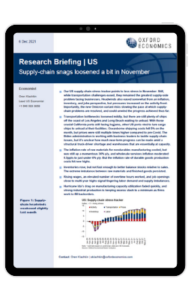US Supply-chain snags loosened a bit in November

Our US supply-chain stress tracker points to less stress in November. Still, while transportation challenges eased, they remained the greatest supply-side problem facing businesses. Headwinds also eased somewhat from an inflation, inventory, and jobs perspective, but pressures increased on the activity front. Importantly, the new Omicron variant risks slowing the pace at which supply-chain problems are resolved, and could unwind the progress achieved thus far.
What you will learn:
- Transportation bottlenecks loosened mildly, but there are still plenty of ships off the coast of Los Angeles and Long Beach waiting to unload. With those crucial California ports still facing logjams, other US ports vied to lure cargo ships to unload at their facilities.
- The inflation rate of raw materials for nondurables manufacturing cooled, but was still up a momentous 36% y/y, and wholesale services inflation moderated 0.5ppts to just under 6% y/y. But the inflation rate of durable goods production costs hit new highs.
- Inventories rose, but not fast enough to better balance stocks relative to sales. The extreme imbalance between raw materials and finished goods persisted.
Tags:
Related Services

Post
House prices continue to slide for China’s cities
Research Briefing US Supply-chain snags loosened a bit in November While the property market downturn has been universal, the scale and depth has been varied for different cities and regions.
Find Out More
Post
The Construction Productivity Challenge in Australia
Delve into the state of construction productivity in Australia. Understand the factors affecting growth and how innovation can transform the industry for the better.
Find Out More